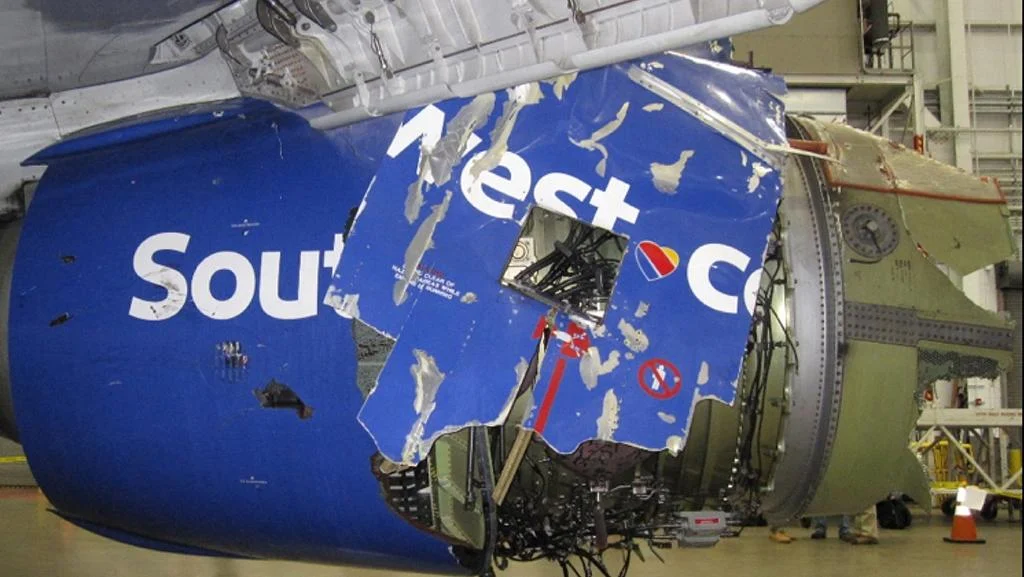
The probe of an April 2018 engine failure on a Southwest Airlines 737-700 that led to a passenger fatality prompted investigators to conclude that Boeing must redesign CFM56-7B nacelles. The new design is meant to prevent parts from shedding and damaging the fuselage and flight control surfaces.
New requirements to mitigate risks from maintenance errors are complicating Boeing’s already prolonged effort to get regulatory approval on its planned 737 Next Generation nacelle retrofit.
Boeing detailed its progress in a mid-July exemption request to the FAA, highlighting the new requirements as its largest remaining stumbling block. The nacelle redesign work is done, the company wrote. But it asked to have until the end of 2024 to study and develop fixes to help reduce the risk of an uncommon but possible mistake, such as leaving a fan cowl door unlatched.
“Boeing is aware of a limited number of incidents in which operator maintenance errors . . . have led to fan cowls and [integrated drive generator] doors departing during takeoff or landing,” the company told the FAA. “Therefore, Boeing is submitting this request for an additional extension of the previously granted exemption to allow Boeing to work with operators and the FAA to address these undetected maintenance errors and ensure full compliance.”
The redesign is based on findings from an NTSB investigation into the April 2018 accident involving a Southwest Airlines 737-700 that prompted a recommendation to redesign the 737 Next Generation (NG) family nacelles and retrofit them fleet-wide. Boeing agreed and has been working with the FAA on this issue for nearly four years (Inside MRO November 2021, p. MRO5).
In August 2021, Boeing asked for seven years to complete its work and have the design retrofitted. The FAA formally responded in July 2022 by giving the company one year to address agency concerns about the proposed design and develop baseline retrofit instructions. Boeing’s most recent request indicated that the design work and retrofit instructions were complete, but it needed more time to comply with requirements that were not in place when the 737NG family was originally certified in the 1990s.
“The requirement for addressing undetected maintenance errors is new policy guidance” linked to the FAA’s Part 25 “Powerplant Installation” regulations, Boeing wrote.
The policy letter is not public. Sources with knowledge of its contents tell Aviation Week that it addresses a specific issue raised by Boeing related to the CFM International CFM56-7B nacelle redesign.
The policy is apparently linked to a broader update to system safety assessments (SSA) in the rulemaking stage. Draft versions of advisory circulars (AC) that will accompany the new SSA rule shed light on the agency’s thinking—and what Boeing is facing on demonstrating that the CFM56-7B nacelle redesign and related procedures minimize the likelihood of inflight fan cowl door separations.
“Many of these events resulted from the maintenance crew improperly closing the fan cowl and securing the latches,” states the draft AC on complying with updated powerplant installation requirements. “In addition, flight crew preflight walk-around inspection procedures were not effective because the maintenance error remained undetected. Maintenance crews have left nacelle fan cowl doors unlatched in service on some airplane models that are more susceptible to this maintenance error. Consequently, the past accepted assumption that maintenance crews will properly latch nacelle cowls and flight crew and maintenance crew procedures will reliably detect an unlatched nacelle cowl during a visual inspection is not valid for all airplane designs. Therefore, an unlatched cowl door, which can jeopardize safe operation of the airplane, is an unsafe system operating condition.”
That puts the condition under Part 25.1309 rules, which use SSAs and other methods to evaluate failures and their potential ramifications.
Boeing acknowledges the risk of a maintenance mishap involving a 737NG nacelle system door but concludes that the likelihood of such an instance in the next 18 months “is extremely remote,” it told the FAA. Under the FAA’s “qualitative probability” definition, extremely remote failures are not likely to occur during a single airplane’s service life but will likely happen “a few times” across an entire sub-fleet’s lifetime. The exemption request does not provide details on Boeing’s analysis.
Fan cowl door-related incidents have plagued industry for years. Many of them were linked to designs or procedures that did not take human factors issues into account. A rash of incidents on A320s led Airbus to add locking mechanisms and a flight-deck warning system.
In addition, certification requirements allow manufacturers to categorize fan cowls as structural parts; that is, they only need to demonstrate tolerance to loads that might be encountered in flight. If instead fan cowls had been characterized as part of a system, SSAs would be required.
The issue has led the European Union Aviation Safety Agency to introduce a new special condition covering engine cowl retention and ensuring that single points of failure, such as unlatched doors, do not lead to cowl losses. The FAA’s new SSA rule will effectively do the same thing for aircraft that must comply with Part 25.





